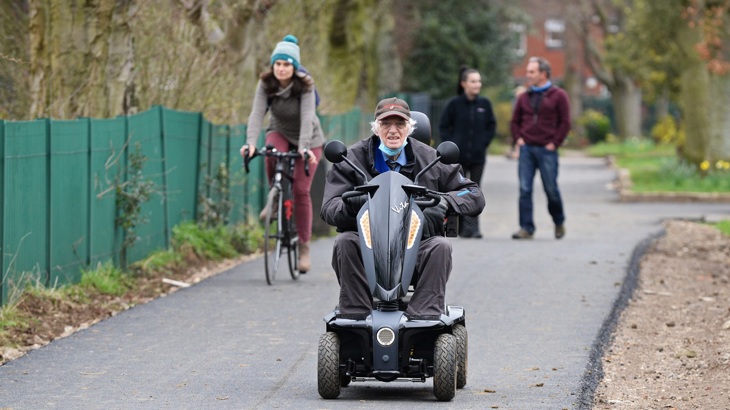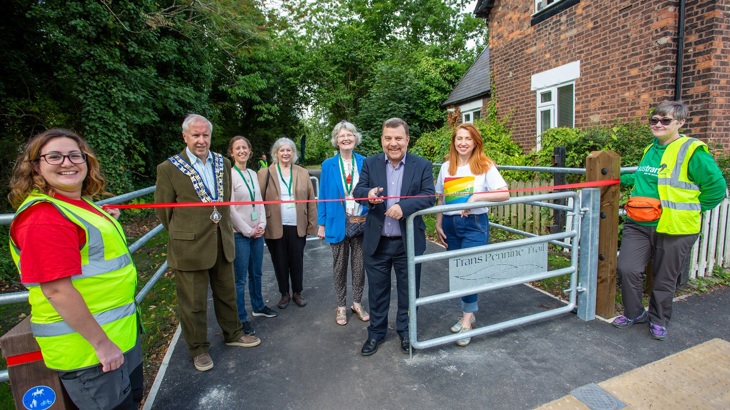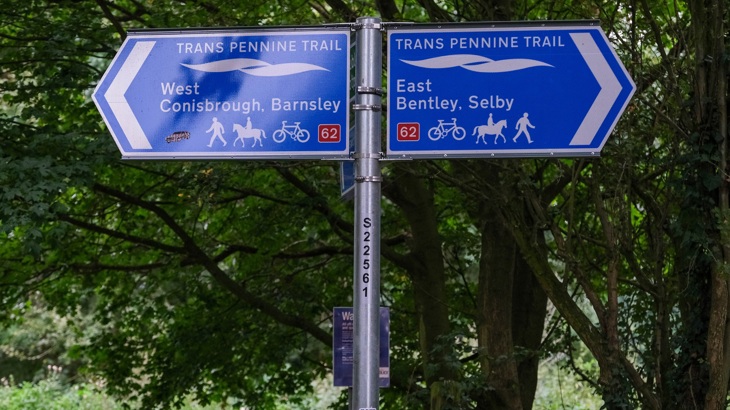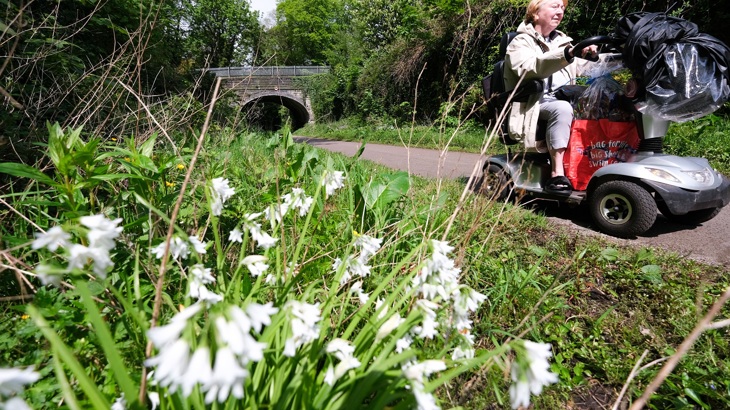The much-loved Trans Pennine Trail traverses some of the North’s most historic towns and cities. It already provides many popular paths for local communities, as well as a long-distance coast to coast challenge route, but has the potential to benefit many more people. We’re working in partnership with local authorities and the Trans Pennine Trail National Office to improve accessibility along the Trail, so it’s a route for everyone to enjoy.
Opening up the Trans Pennine Trail
About the Trans Pennine Trail
The Trans Pennine Trail (TPT) is one of our most iconic Northern routes on the National Cycle Network.
Thousands of people use the path each year, on foot, bicycle or horseback.
The Trail connects Southport in the west of England to Hornsea in the east.
It runs through Hull, Sheffield, Leeds, Manchester and Liverpool, via old railway lines and canal towpaths, as well as sections through Doncaster, Barnsley and Wakefield. There are also spurs to York, Selby, Kirkburton and Chesterfield.
The Trail includes Route 62, as well as some parts of routes 6, 67 and 55 on the National Cycle Network.
Most of the Trail is flat and traffic-free.
The coast-to-coast route (running from Southport to Hornsea) is 215 miles. And with additional spurs it spans over 370 miles!
For most people the Trail is a beautiful local path.
It’s a quiet, natural place to walk the dog, meet friends, or commute to work or school. Much of the Trail is also a bridleway, so it’s popular with local horseriders too.
Each year many experienced cyclists also ride the challenging route all the way from Southport to Hornsea.
But the Trail also has enormous potential to be a long distance, accessible path for everyone. An active travel greenway connecting communities between our vibrant Northern towns and cities.
Our work to improve the Trail
As part of our Paths for Everyone programme, we’re working with local authorities along the Trail, and in partnership with the Trans Pennine Trail National Office, to improve the surface of the route and remove barriers to help more people access the path for travel and leisure.
Thanks to our funding partners the Department for Transport, Active Travel England and local authorities.
Barnsley, South Yorkshire, 2020- 2022
Our North team worked with Barnsley Council and the Trans Pennine Trail National Office to improve accessibility, surface and drainage on two sections of route.
First, a 3.1km section between Smithywood Lane in Dodworth and Haverlands Lane in Worsbrough.
The path was widened to 2.5 metres and a porous, flexible rubber surface laid, made from recycled tyres (Flexipave).
Further surface and access improvements on the Trail were made between Smithywood Lane and Black Horse Drive, Silkstone Common.
In addition, a wildlife trail was installed between Worsbrough to Silkstone Common.
The Trail includes information about different species, on the route, with activities for families.

Sustrans worked with Doncaster Council to resurface this section of the Trans Pennine Trail between Bentley park and Shaftholme Lane in Doncaster. Credit: Marie Caley/Sustrans
Doncaster, South Yorkshire, 2020-2024
We worked with Doncaster City Council as well as the TPT National Office to improve a 3km section of route between Bentley Park and Shaftholme Lane in Doncaster.
At the time of the improvements, local resident Rob Hughes used a mobility scooter and regularly went out on the Trans Pennine Trail. He recounts his feelings when he came across the improvements:
“I was really, really chuffed. When I got on there it was incredible. The tarmac makes it a smooth ride now for everyone. It’s so nice to see it being well-looked after and accessible for people in wheelchairs, mobility scooters or with buggies and prams.”
The second phase included surface improvements and widening of the trail between Mill Lane and Mexborough. Doncaster also installed new signs and better seating.
In 2024, we worked with the Council on further improvements on a one-mile section between York Road and Melton Road/Sprotborough Road. This now has a new flexible surface, with better access for disabled people, young families, and horses. The team replaced several barriers to make them accessible and installed five benches along the path.
Our community engagement team also worked with the local community to plant wildflowers, pick litter and other tasks to look after this section of the route in the longer term. We also developed an activity trail for families.

A community celebration in Lymm for the new access point and improved surfacing. Credit: Chris Foster/Sustrans
Lymm, Cheshire, 2023
We worked with Warrington Borough Council and TPT National Office to improve accessibility and surface of the route between Reddish Crescent and Whitbarrow Road.
This included removing six barriers to allow wheelchairs and other mobility aids or double buggies to pass through.
We also worked with a local school to give the Millenium Milepost near the ranger hut at the Whitbarrow road entrance a striking new look.
Four primary schools in Lymm submitted colour schemes for a Sustrans competition to redesign the milepost. The winning design was created by Maria Harrison from Cherry Tree Primary School.
The second phase of work in Lymm was between Whitbarrow Road and Camsley Lane subway.
On this section our team laid a new Flexipave surface and replaced cumbersome A-frame barriers on Star Lane, which prevented people in wheelchairs or mobility scooters from getting on the trail with new, accessible versions.
Liverpool Loop Line and Cheshire Lines, 2023
We worked with Liverpool City Council to improve the surface of the Liverpool Loop Line and to redesign 10 barriers to be accessible for mobility aids, adapted cycles and buggies.
We also worked with West Lancashire Council to improve accessibility on a section of the Cheshire Lines, which links to the Liverpool Loop Line, between the old Lydiate station and Maghull.
Solar System Way, York, 2021
Our team worked with City of York Council and the TPT National Office to improve accessibility on the Trail between Naburn and Riccall.
This section of route was damaged by tree roots. The team laid a new surface and installed new access controls to allow a much wider variety of users to access the path.
Our community engagement team also worked with local volunteers to enhance the habitat along the path.
Five Weirs Walk, Sheffield, 2024
We worked with Sheffield City Council and the TPT National Office to resurface and widen the city’s much-loved Five Weirs Walk on the section between East Coast Road and Stephenson Road. This means mobility scooters, larger buggies and cycles can access the route.
Local resident Deborah Carter said she was delighted with the improvements:
“I learnt to ride a bike again after an accident with my leg. I have to have a special pedal as my leg won’t turn properly.
“I used to like riding in Sheffield but I’ve missed it. I’m really pleased to see the changes on this route. I remember it from before. I didn’t like it then as I found it scary. Now I’ll definitely come back on my own.”
Our team also installed a new bench along the route. Volunteers also helped to cut back vegetation, plant bulbs and pick litter along the path.

We work with the Trans Pennine Trail national office and local authorities to improve signage along the route. Credit: Sustrans
Vision
We're proud of the improvements we have made so far with local authorities and the TPT National Office. Imagine how many more people would have access to the route if we could replace restrictive barriers and improve the surface right across the country.
The Trans Pennine Trail is also Route 62 on the National Cycle Network, the active travel version of the M62. With investment, the Trail could become the North’s own active travel super greenway.
It could connect to on-road walking and cycling paths linking to schools, workplaces and services.
Thousands, even millions of people could benefit from a safe, traffic-free path which they could use for everyday journeys or just a peaceful green space to enjoy nature, on foot, cycle, wheelchair or horseback.
The TPT National Office estimates that we need to invest around £67 million in the route to make it accessible for everyone. The Trail passes through 26 local authorities. We want to work in partnership with them and the TPT National Office to make this happen.

Wildflowers on the Liverpool Loop Line. Credit: Denis Oates/Sustrans
A route for wildlife as well as people
The Trans Pennine Trail is a haven for wildlife across the country. It passes through numerous large urban areas, so its tree-lined tracks provide a vital corridor for many species of birds, bats and amphibians. In urban areas it helps to link habitats together.
Reducing carbon
16,000
Recycled tyres used in 3km section between Worsbrough bridge and Smithywood Lane in Barnsley
£67 million
Estimated cost to make the trail accessible for everyone.







